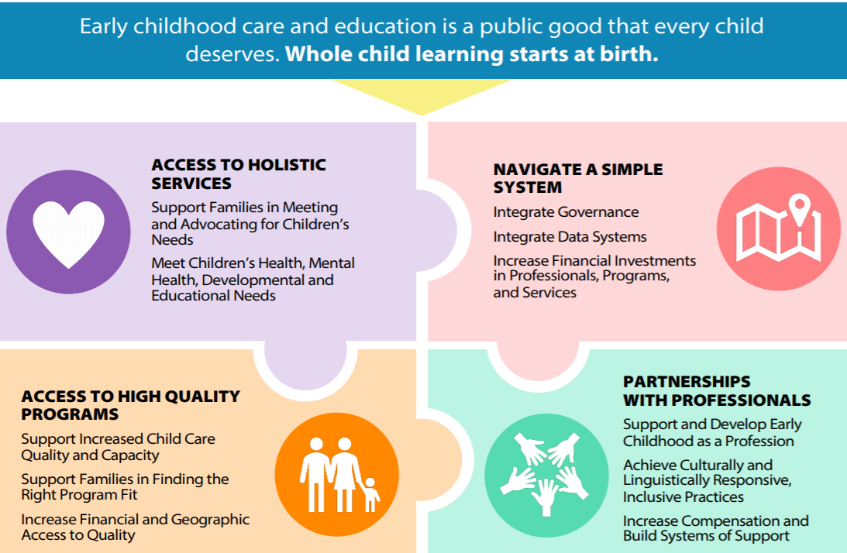5 Key Takeaways from the Early Childhood Council’s Strategic Plan

As holidays approach during an extra stressful year, families with young children are no doubt extra grateful for the childcare providers in their lives. The local industry has adapted mightily to help kids and families, and the Delaware Early Childhood Council is responding to the times with its new strategic plan. The plan celebrates progress in early learning, but outlines the important work ahead. Below are five takeaways from the plan that highlight the Council’s desire to build on the progress made and continue to improve early learning in Delaware.
- We’ve Come a Long Way
Since the first Delaware Early Childhood Council strategic plan in 2008, Delaware has made key improvements in early learning.
Investments in the quality of childcare programs and the workforce include:
- Increased access to high quality programs for children ages 0-3
- The expansion of pipelines, pathways, and scholarships for pre-service early learning teachers
- Resources for the early learning workforce to support retention and finances.
Developments in wrap-around, holistic services include:
- Wide expansion of developmental screenings for all families with children ages 0-5
- Integrated pediatric well-visits that focus on wrap-around supports for children ages 0-5
- A more coordinated effort to scale mental health services and screenings for children
Improvements in early learning and system-wide alignment include:
- Some consolidation of governance to streamline information for families and providers
- Investments in quality care through increased Purchase of Care subsidy rates
- Increased access to information with the launch of a resource portal and kindergarten readiness campaign
- Early Learning is an Equity Issue
We know that when a child participates in early learning opportunities, they are more likely to thrive in school and in future endeavors. We also know that despite progress in the field, Delaware still faces significant challenges. Only about ½ to 2/3 of students enter kindergarten with the skills they need to succeed, such as literacy, math, and social emotional skills. That correlates with the fact that half of all Delaware 4-year-olds have no formal pre-K before entering kindergarten.
Geographic barriers create obstacles for families looking for quality childcare for their child. Childcare deserts exist where programs aren’t readily accessible across the state. For example, Sussex and Kent counties have almost half of Delaware’s birth through five population but only 38 percent of childcare programs.
Hours of service and age groups served at childcare facilities also pose problems for families with only three percent of childcare centers offering extended hours and only 77 percent of programs accepting infants under one year old.
Families also continue to have limited, insufficient access to holistic services across the state. Children with disabilities can wait up to three months for services due to an insufficient amount of service providers and lack of coordination. This barrier not only creates confusion for families, but could delay interventions, resources, and supports that students with disabilities require early on. Families who need dual language services will also experience delays in the process. For example, only 13-20 percent of programs employ staff who speak Spanish.
- Families and Providers in Crisis
Even before COVID-19 and the financial hardships it brought, childcare in Delaware was restrictively expensive. Childcare for one child takes up approximately 20 percent of the median family income, or around $13,000 per year per child. State investments in Purchase of Care (POC), a subsidy that helps low-income families access high quality childcare, are helpful, but POC doesn’t come close to covering the true cost of care. The strategic plan highlights that parents who take higher paying jobs are penalized because they no longer qualify for POC but still have significant child care expenses.
The pandemic has increased challenges for families and childcare providers. Families are extra stressed balancing work, family demands, and childcare in a new way. The strategic plan states forty percent of employers are concerned that some employees will not fully return back to work because of childcare needs. Parents need reliable childcare to keep their jobs and many have expressed their concern that without open childcare facilities, children would lack social interaction and be unproductive at home.
Since March, many childcare facilities have closed or severely limited their capacity. Childcare providers’ expenses have also gone up 40 percent while enrollment is down 50 percent. To help childcare facilities survive, the government issued enhanced reimbursements through Federal CARES funding and will continue until the end of December. Many childcare providers and advocates are urging Governor Carney to continue enhanced reimbursements into 2021 in order to keep their doors open, continue to serve kids, and keep costs down for families.
- Supporting the Workforce is a Dire Need
Central to high-quality early learning are talented, well-compensated teachers and leaders. Currently in Delaware, early childhood care and education professionals receive poor compensation and lack benefits, especially when compared to their K-12 counterparts. The average annual salary in Delaware for a pre-K teacher is $29,000, while the average salary for a kindergarten teacher comes in at $60,000.
About 13 percent of the early learning workforce maintain a second job to supplement their income and only 40 percent have healthcare benefits. In terms of professional development and training, only 61 percent of early childhood educators have a high school degree and most have limited training. Once in the profession, the support system is inconsistent at best with professional development offerings undervalued and inaccessible. In order to support the workforce, there must be an increased investment in compensation so we can pay early learning workers a living wage and retain more early childhood educators.

- Bold Next Steps
Delaware must continue to sustain and grow investment in early childhood education and childcare. All families and children deserve access to holistic services and high-quality early learning while the profession deserves fair pay and professional support. The Early Childhood Council recommends a well-resourced, integrated early childhood system that streamlines information for families, supports the early learning workforce, and provides access to high quality programs and holistic supports for the development and growth of all children. To accomplish this, the plan outlines many actionable recommendations for next steps. Highlights include:
- Offer community-based mental health services and supports for all birth-8 children and their families, including integrating into pediatric well visits.
- Expand availability of high-quality services for children with disabilities and develop supports for families of dual language learners, including translation services.
- Increase state investment to reimburse all programs based on the cost of quality care.
- Simplify the number and increase the quality standards through the Stars Quality Rating and Improvement System and require publicly funded programs to reach a minimum level of quality.
- Invest in universal, mixed delivery pre-K for all three- and four-year olds and invest in extended hours and flexible models for childcare.
- Develop and expand existing pipelines to the profession and establish partnerships to offer professional development across systems.
- Increase compensation of early childhood professionals to K-12 educator levels and offer benefits such as healthcare and paid time off in tandem with increased qualification requirements overtime with support.
Related Topics: delaware early childhood council, Delaware education, early childhood education, early learning